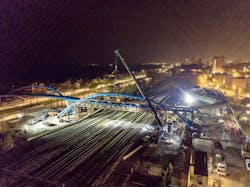Artistic Chicago pedestrian bridge span requires precise crane work
This summer, a curving blue metal structure under construction along Chicago’s lake shore captured the attention of residents and local media because of its resemblance to a roller coaster. Had some enterprising amusement company chosen to build a thrill ride along Lake Michigan? Turns out that the eye-grabbing project was actually the new 41st Street Pedestrian Bridge. Winner of an international design competition, the bridge spans the Illinois Central rail tracks below to get residents of the South Side neighborhoods to Oakwood Beach.
Construction of the bridge had several complicated factors. First, the location: its close proximity to railroad tracks, a large body of water, and busy thoroughfare Lake Shore Drive. Second: the overhead catenary lines—the suspension cables that power railroad vehicles. Third: the artistic, twist-and-turn design of the bridge itself.
Central Contractors Service, a division of the ALL Family of Companies, got the call from general contractor F.H. Paschen to handle the complex, exacting crane work.
The city would not authorize lane closures of Lake Shore Drive during the day, so all work had to be done at night. Ideally, the crane would have been situated either directly on the railroad tracks or on the median separating the northbound and southbound lanes of the roadway. Because neither could be reasonably accomplished, Central Contractors Service employed its newly acquired Liebherr LTM 1450-8.1, with its more than 250 ft of main boom.
First, temporary shoring had to be constructed over the railroad’s catenary lines to support the bridge beams as they were being bolted in place. “This was a three-phase project,” said Paul Urbanski, sales manager of Central Contractors Service. “Getting that shoring in place over the catenary lines let us get the first phase of the bridge finished.”
Next, crews moved to the southbound lanes of Lake Shore Drive to begin building the other side of the bridge. When that was done, they moved to the middle portion over the northbound lanes.
“Keep in mind, none of the pieces were straight,” said Urbanski, referring to the sinuous nature of the bridge that first caught the eye of the public and the media. “One end would be shooting out of a concrete support at an angle. We had to have it rigged just right. Then our operator had to place the piece on the temporary shoring so the anchor bolts could tighten it down and connect it to the span.”
According to Urbanski, the Liebherr LTM 1450-8.1 performed beautifully despite the extremely long reaches, the heavy weights of the beams and having to get into position in some very tight spaces.
The crane’s swinging counterweight system came in especially handy when working around railroad power lines. “With counterweights you can adjust on the fly, we were able to set up the crane to a minimum counterweight and swing to avoid the power lines,” Urbanski said.
